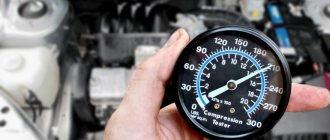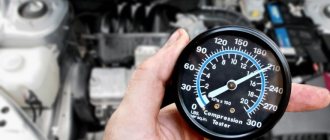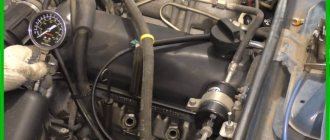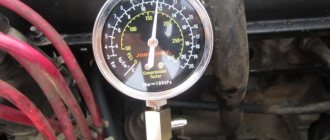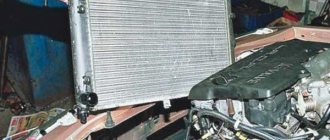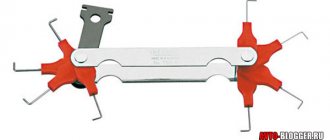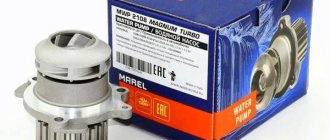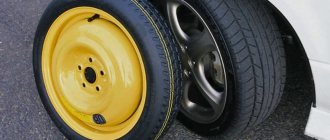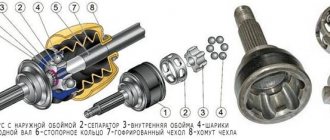During the working cycle of the VAZ 2114 internal combustion engine, four stages occur. The first stage involves intake or compression, during which the piston moves from top dead center (TDC) to bottom dead center (BDC), at which time the intake valve opens to supply the fuel-air mixture.
On the second, the piston rises from BDC to TDC, compression occurs, that is, the pressure rises sharply because all the valves are closed, the temperature rises and the mixture is ready to ignite. The higher the compression, the higher the power and efficiency of the engine.
The mixture ignites in the third stage, when the piston reaches TDC. Due to the released energy, the piston moves towards BDC.
In the fourth stage, when the piston is reversed, the exhaust valve opens and the burnt gases are pushed out of the working cylinder. When TDC is reached, all valves close and the piston is ready to repeat the entire four-stroke cycle.
Invalid compression values for the engine
At first glance, it may seem that the higher the compression parameters of the air-combustible mixture, the better. But actually it is not. Compression has an upper threshold that cannot be crossed, as this will lead to overheating of the engine, and, as a result, deposits of carbon deposits, excessive load on the pistons and rings, as a result of which engine parts may fail.
Low pressure in the engine leads to excessive consumption of fuel and oil. It is not permissible that in individual cylinders it differs sharply from neighboring ones. Different compression in the cylinders indicates serious problems in the engine - wear and defects that have appeared that require replacement or repair of parts.
Thus, bad compression is:
- increased,
- low,
- different.
All of these signs of poor compression are a sign that the heart of the car needs repair.
What should be the compression in the engine?
How much compression should be in the engine for its long-term and trouble-free operation? Long-term practice of operating cars shows that ideally it should be 14 barrels in each cylinder. But a reduction to 11 barrels is allowed, provided that the difference in compression in the cylinders should be no more than 1 barrel. For example, a compression pattern of 11-12-11-12 is considered acceptable, but if the pressure in different cylinders is 11-12-11-9, or another combination of indicators that differs from normal, then the engine already needs repair.
What compression should be on a VAZ 2114 8 valve also depends on how long and under what conditions the car is operated. Ideal pressure, as a rule, occurs with a new engine, or one that has just come out of a major overhaul. During vehicle operation, compression may drop by 1-2 barrels. And this will also be within the normal range.
How to take measurements
An important role is played by the conditions under which the measurements were made. The fact is that the indicators may be different depending on the parameters and the method of their removal. You can determine what compression should be in a diesel engine or a gasoline engine not only by the type of fuel. The result may depend on the following circumstances:
- The amount of air entering the cylinder.
- Was the engine warmed up and to what temperature?
- Engine type (carburetor or injection).
- At what frequency does the crankshaft rotate?
- Oil viscosity: the higher it is, the greater the degree of air compression. If compression indicators, on the contrary, are increased, and the car’s mileage is more than 250,000 km, this means that a thick layer of used oil has accumulated on the cylinder walls. As a result, the combustion chamber becomes smaller in volume, thrust decreases, but compression during measurements remains normal.
Under certain conditions, the result may deviate upward. The reasons may be as follows:
- There is a large amount of oil in the combustion chamber.
- The engine is overheated or too hot.
- The throttle valve is open all the time.
What causes too high compression?
Let's look at the main reasons:
- Incorrect adjustment of the timing belt leads not only to increased compression, but also to decreased compression, depending on the direction of regulation.
- The appearance of scale on the valves, which appears due to the use of low-quality gasoline, oil or other automotive chemicals. Carbon deposits on the throttle assemblies and in the combustion chamber also appear due to engine overheating. Thus, overheating of the internal combustion engine is not only a consequence, but also a cause of high pressure of the air-combustible mixture. The operating temperature of the VAZ 2114 8 valve engine should not exceed 85-90°C.
- High compression can be caused by stuck oil seals. This reason is not difficult to detect. You just need to unscrew the spark plugs and inspect the cylinders. The appearance of an oil film on their walls will indicate an excess of oil in them, and the need to change the caps.
Compression is also affected by the level of oil pressure in the engine. If it is too high, then this leads to increased pressure of the air-combustible mixture.
Low pressure occurs if the rings are worn out or the valves are burnt out. The operating temperature of the engine also affects. If it is below normal, this will also affect the pressure of the air-combustible mixture.
The reasons for the lack of compression in the engine lie in improper operation and untimely preventive repairs. Sometimes air breaks through from several sides at once - for example, through valves, and at the same time through pistons with rings. Then the pressure disappears completely. It's simply not acceptable to let the car get into this state.
We carry out checks for an 8 valve car
So, the procedure for checking the motor yourself is not particularly difficult. Having the necessary skills and a device with which you can measure pressure, the procedure can be carried out independently. Naturally, for this you will have to follow certain requirements, which are listed below. If you know what the compression should be in the internal combustion engine, then you can start working.
Step by step instructions
The first thing you will need to measure the pressure level in the engine is a device with which you will do this. How can we measure this coefficient? The device for this is called a “compressometer”. Such a device can be of several types:
- universal device;
- threaded;
- flexible;
- clamping
This is what the pressure measuring device looks like disassembled
You will need to find such a device. Also, in this matter you will need the help of a friend, since you will have to simultaneously perform some actions both inside the cabin and in the engine compartment. In addition to the compression gauge, prepare a wrench for removing the spark plugs. Please note that it is better not to perform any work if the battery is not working. Therefore, fully charge your battery. So, let's start checking:
- First, get behind the wheel and start the engine. Let it idle and warm up to 90 degrees, that is, to operating temperature.
- After this, open the hood and take the key to remove the spark plugs. You need to remove the high-voltage wires, and then dismantle all the spark plugs. The wires fit to the spark plugs, you just need to pull them out.
- Now remove the ECU fuse to avoid possible damage to the device.
- When the spark plug is dismantled, you need to install your device in its hole to check the pressure level. Do this carefully so as not to damage the threads.
- Now you will need a friend's help. Ask him to sit in the driver's seat. The assistant must press the gas pedal all the way so that the throttle valve can open completely.
- Then turn on the starter and turn the crank pulley with it. This is done until the readings on the compression gauge stop increasing. As a rule, this takes no more than 10 seconds. In this case, the crank pulley must rotate, and its rotation speed should not exceed 100 rpm.
- Now you can read the received readings. Better write them down. Remember what the compression should be and compare these readings with the received ones. Once the readings are recorded, the device's needle can be set to zero.
- This procedure should be repeated for each cylinder of the VAZ 2114 8 valve engine.
As you understand, there is nothing particularly difficult in this procedure. You just need to carry out all the measuring steps correctly and you will get the most accurate results.
How to measure compression correctly
Engine compression is measured with a fully charged battery. After charging and installing the power source in place, check the starter. It shouldn't create any problems either. Then warm up the engine. Its temperature during measurements should be 70-90°C.
It is necessary to unscrew all spark plugs from all holes. Also unscrew the fuel hose to stop the fuel supply. Prepare the compression gauge for use.
Compressometer
conclusions
It was found that normal compression for a VAZ-2114 engine is 11-14 bar . An increase or decrease in this indicator, as well as a gap of more than 1 bar between the cylinders, is not considered normal and is subject to diagnosis. Engine compression is measured using a compression gauge.
There are several inaccuracies. Firstly, compression is traditionally measured with the engine not running at the starting speed generated by the starter! This is important: the pressure at the end of the compression stroke depends on the crankshaft speed, so if the engine is running, the compression will be much higher than the specified range - up to several times! Secondly, compression is measured on a warm engine (although there are some “former” ones who measure it on a cold engine, but the result is no more than a “funny letter”!). Third, the throttle must be fully open. Otherwise, the required amount of air will not be supplied, so the readings will be underestimated (there is nothing to compress!). On an injection engine, when the throttle valve is fully opened, the fuel supply and sparking stop (so-called cylinder purging). So there is no need to additionally turn off the ignition system (unlike carburetor engines). Fourthly, not only the absolute value of the pressure itself is important, but also how quickly it builds up. This indicator characterizes the condition no less accurately than the pressure itself. Ideally, a fixed value should be achieved in 2-3 “pumps”. And fifthly, the compression level is also affected by the condition of the starter and the flywheel ring gear: if the teeth are worn out and jammed, the compression value will also be underestimated. In general, for a more accurate assessment of the condition, the leak method is now much more often used.
Source
How to measure compression with a compression meter
A device consisting of a pressure gauge and a rubberized tube that measures compression in the engine is called a compression gauge.
The following devices are used:
- clamping,
- universal,
- flexible,
- threaded
Experts believe that of all types of compression gauges, it is better to use threaded ones. They provide more accurate information. It is necessary to measure the compression in the engine in each cylinder separately. The measuring instrument hose is inserted into the spark plug socket.
Now that everything is ready for measurements, start the engine and squeeze the gas all the way, let the engine run for a while. Check the pressure gauge readings and record them. Move the compression tester hose to the next spark plug hole, and take measurements in the second and subsequent cylinders in the same way. Write down all the results and compare them.
What should the compression be in an injection engine?
Below you will learn how to correctly measure compression in a VAZ 2114 engine with injection type power.
If in at least one cylinder the pressure gauge shows a pressure below 10 barrels, then we need to look for the reason for such a low indicator. Otherwise, very soon it will fall in other cylinders.
Fill a medical syringe with about 10 milligrams of oil and spray it into the cylinder. Take the measurement again. If the pressure gauge readings increase, it means the piston rings are worn out and require replacement. If it remains at the same low level, then it is necessary to adjust the clamped valves or replace the burnt valves.
Downward change
There are 2 types of deterioration in performance: a decrease in pressure in all 4 cylinders or only in one, less often in two. The limit at which immediate repair is required is considered to be 11 bar. When the compression is low at all 4 measurements, then you need to look for one of the following faults in the engine:
- The piston rings have expired. The pressure drops gradually as it wears out. It is considered a completely natural process.
- The same, the entire piston group. Due to the operation of the crankshaft, the cross-section of the cylinders becomes ellipsoidal rather than round. Gaps form between the walls and the pistons that even new rings cannot cover.
- The valves were covered with soot on the inside (in jargon: burnt) and lost their tightness. Carbon deposits prevent the valve from completely seating and closing.
- The rules for adjusting the thermal clearances of the valves were grossly violated. When there are no gaps, after the engine warms up, the valves are constantly slightly open. This most harmless malfunction can be eliminated by adjustment, after which the compression must be re-measured.
The first 3 malfunctions, as a rule, come together and definitely lead to disassembly of the power unit. It rarely happens that after removing the cylinder head, only ring wear is discovered. Typically, valves and seats also need to be cleaned and wiped, and there is an ellipse-shaped development inside.
Another option is when compression has disappeared in one place: just yesterday it was there, but today the car is already “sneezing” on 3 cylinders. The reasons are as follows:
- became covered with soot and 1 valve or 2 adjacent ones stopped closing;
- due to overheating, one piston expanded more than the others and stripped the cylinder walls;
- error when adjusting the valves, one of them is very “clamped”.
As in the previous case, the final diagnosis is made after disassembling the motor, examining and measuring the size of the ellipse. Scratches on the inner walls will be immediately visible and will lead to the replacement of all pistons along with rings and repair of the cylinders.
How to measure compression without a compression gauge
Is it possible to measure compression without a device? Practice shows that yes, it is possible. But this method will give relative and approximate readings. To measure the compression indicator without instruments, remove the spark plugs from all cylinders except the one being tested. Manually rotate the crankshaft until the compression stroke ends (watch the marks - they should match). Perform this operation on all cylinders one by one. Where the pressure is low, it will take less effort to turn the crankshaft. In this way, of course, you will not get accurate compression readings in the engine. But it is possible to understand the presence of problems.
It is recommended to measure compression every 20-30 thousand kilometers, so every car enthusiast is recommended to have his own compression gauge. Its price is not so high that it is worth saving on it.
The approximate price of a device for measuring engine compression in online stores in the capital is from 600 rubles to 2 thousand. Branded models from Western manufacturers are more expensive – up to 8 thousand. In the regions, a device for measuring compression costs no more than in the capital. Its price varies depending on the manufacturer.
Why is verification needed?
The compression of the VAZ 2114 8 valve engine indicates the working condition of the engine. This indicator determines the engine power and its service life. The process of measuring the compression of a VAZ 2114 8-valve engine should be carried out at least every 20-30 thousand kilometers. In addition, this should be done before purchasing a car.
VAZ 2114 car with 8 valve engine
How to correctly measure compression in engine cylinders
Engine compression indicates the condition of the engine, its service life, power, and torque. This procedure must be performed every 20-30 thousand kilometers, as well as before purchasing a car. Even when checking at a service center, YOU will need knowledge of “how to correctly measure compression”, because... Servicemen love to deceive and make money from you. Let's start with the theory: Compression is the pressure created in the cylinder at the end of the compression stroke. Another term is appropriate here: Engine compression ratio. The engine compression ratio is expressed in the following ratio: compression/combustion chamber volume.
What compression should be in the cylinders of a VAZ engine?
Normal engine compression is at least 10 bar (1.0 MPa), and the difference between the cylinders should not exceed 1 bar (0.1 MPa). If your compression is 11-12-11-12 from cylinders 1 to 4, then the engine is fine, but do not forget to adjust the valves every 2500 km. If you have 11-9-12-11, then you need to look for the reason and make repairs, because Driving in such conditions will only kill the engine.
How much should the ideal compression be? The ideal compression should be 14 bar for an 8-valve engine in each cylinder with minimal variation (14-14-14-14).
Repair
As I wrote above, it’s really difficult to make repairs yourself. Unless, of course, you have a blown gasket, it’s possible to repair it, but again, it’s not so easy. How to replace a short video.
Diagnostics are carried out with the cylinder head removed - here the malfunction can be determined 100%. You are unlikely to do it yourself; contact specialists at a service station, or people who understand.
I think my article was useful to you - read our AUTOBLOG.
(
27 votes, average: 4.11 out of 5)
Source
How to measure engine compression?
To check the compression we need a spark plug wrench, a charged battery and a compression gauge. You also can’t do without an assistant.
- Warm up the engine to operating temperature.
- We turn out all the candles.
- We install a device for measuring compression (compressometer) into the spark plug hole that appears.
- The assistant presses the gas all the way and starts the car within 6-10 seconds.
- We remember the compression gauge readings and carry out similar operations on the remaining cylinders.
Low and different compression in the engine, what to do?
If, after checking the compression, the compression meter shows below 10 bar in at least one cylinder, then you urgently need to find out the cause and fix the problem, otherwise you risk losing compression in the remaining cylinders.
If, for example, you do not have sufficient compression in 1.4 and any other cylinder:
- We fill a medical syringe with about 10 cubic centimeters of motor oil.
- Spray oil into the hole that appears.
- We measure the compression again.
If, after re-measuring, the compression has increased, it means the rings are worn out. If the result remains the same, it means the valves are burnt out or jammed. Stiff valves can be adjusted, and burnt valves can be replaced.
High compression in the engine. Main reasons.
Don't be too happy if your compression readings are off the charts, this is in no way indicative of how cool your engine is. As stated above, the ideal compression for an 8-valve engine is 14-14-14-14. If your compression is higher than these numbers, then it’s time to think about malfunctions. High compression can damage the partitions of the pistons and tear the cylinders. Below are the main reasons for high/high compression: High compression is created due to excess oil in the cylinder, which is why it is sometimes also called “oil compression”.
- The valve stem seals (VSC) have worn out and died.
- The oil scraper rings are worn out or stuck. (In such cases, oil consumption is inevitable. Check the oil level: How to check the oil level in the engine? Also pay attention to starting the engine after a long stop, for example, in the morning. If the engine oil is consumed, the exhaust will be black).
- There may be carbon deposits in the cylinders. Try to get rid of it by decoking.
Handle the compressor correctly
Before you begin, you need to study the theory of how to use the device correctly and pay attention to the following:
- Before operation, the engine must be warmed up to a temperature no higher than 40-60 degrees Celsius. After this, you need to turn off the fuel supply.
- The battery must be well charged, the charge should be from 12 to 14 Volts.
- Air humidity should be low, so work can be carried out either outside in dry weather or in a heated, dry room with normal humidity.
- Before measuring, the spark plugs must be removed from all cylinders. The ignition must be turned off.
- Please note that compressors are produced differently and may not fit your engine model; this must be clarified before purchasing the device. The fact is that conventional measuring instruments have a short tip, and they are not suitable for 16-valve units.
- Measure compression with a pressure gauge twice. In one case the throttle valve must be fully open, in the other it must be closed. The difference needs to be compared. Ideally, the same compression will be detected in the engine cylinders; the norm is not observed if in one case the indicator is sharply higher, since this means that the engine needs repair.
- It is worth noting that a small error between different cylinders is acceptable, this is due to their uneven wear, but the difference should not be too large.
If you notice that your engine is running worse, then it may be time to check the engine compression level. What should be the compression of VAZ 2114 8 valves? How can I check it? We will tell our readers about this in this article.
How to increase engine compression in other ways?
There are several options for raising compression without repair. These operations do not in any way guarantee an increase in compression, but you can try. But it is still recommended to eliminate the malfunction by mechanical action - eliminate the malfunction: replace the rings or replace the valves.
- Adjustment of valves. I tried it myself, it really works. The valve could be jammed and therefore not close, resulting in a compression leak.
- Roscoking – removes carbon deposits and excess oil in the cylinder. It only helps with stuck rings; if the valves are burnt out, there is no point in carrying out this operation.
